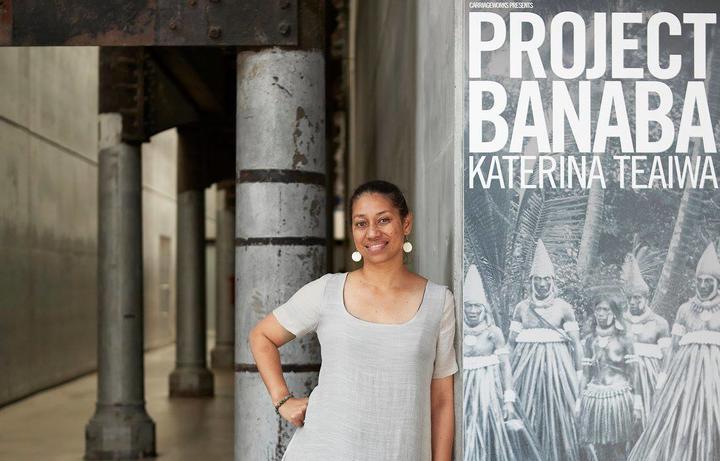Untold mining story of Banaba in art at West Auckland gallery
Wednesday 6 April 2022 | Written by RNZ | Published in New Zealand, Regional

Katarina Teaiwa project Banaba touring exhibition curated by Yuki Kihara. Photo: Te Uru Waitakere Contemporary Gallery
A travelling multi-media installation is currently showing at Te Uru Art Gallery in West Auckland New Zealand.
Titled 'Project Banaba', the installation explores the untold mining history of Banaba Ocean Island.
Award-winning professor Katerina Teaiwa has spent several decades studying the impacts phosphate mining on the Banaban people and their displacement from what is now called Kiribati to Fiji.
Dr Teaiwa said she was unsure of what she wanted to do with all of her research.
"It was my way of trying to disseminate my doctoral research beyond the academy, so I had written a lot of words but I also made films...short video studies about contemporary Banaban life for what the island in Kiribati looked like now and what Rabi island looks like.
"I didn't have a pathway of what to do with my audio/visual and performance content, so I had to kind of put that on the shelf for a little bit because if you're a social scientist or in the humanities, you're expected to publish books and publish journal articles and become an expert in producing texts," she said.
Not wanting to leave all of her research and creative content on the shelf any longer, Teaiwa reached out to other artists to help interpret her work and realised it had the potential to reach out to bigger audiences.

This led Teaiwa to collaborate with renowned Pacific artist Yuki Kihara who could help showcase the project in different locations.
"It started in Sydney, at Carriageworks which is a large gallery and they funded the first exhibition. Then two years later it went to a gallery in Hawke's Bay, New Zealand and now it's just opened up at Te Uru in Auckland," Teaiwa said.
"Everywhere it travels it engages with the place and the history of the place, so it's not like it goes to random galleries - there's always a significance of the communities or the places that this travels to."
When Yuki Kihara engaged with the Banaban community, they wanted to ensure that there were more educational resources to teach young people about the culture and heritage of Banaba.
"I knew I could use my curator practice to not only highlight the contemporary experience of the Banaban community," she said.
"But, we're also developing video resources that would be circulated online to make the thriving Banaban community's presence known in Aotearoa New Zealand and also create awareness, and to also create educational resource for us to learn from the Banaban experience," Kihara said.
The Auckland Banaban Christian Fellowship Hub was approached by Dr Katerina Teaiwa and curator Yuki Kihara to ensure that the content in 'Project Banaba' was educational for audiences to learn about Banaba which is not widely known.
Raising awareness and sharing the history of Banaba has been a long time coming, said Banaban community leader, Maggie Kaipati.
Kaipati said being involved in the project has brought the community closer.
"The fellowship played a very important role in the success of the 'Te Kaneati' curated by Yuki Kihara alongside 'Project Banaba' by Katerina Teaiwa," she said.
"This workshop brought a sense of nationalism that emerged among our community members. There was unity, togetherness, and determination that everyone involved in it worked wholeheartedly.
"Their determination successfully delivered our unique story, history, and culture which is now showcasing at the Te Uru gallery," she said.
Project Banaba will run until Sunday 29 May 2022.














































